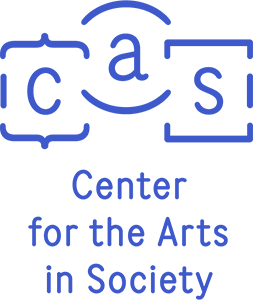CAS Narrative - End of the World, et al
Let’s start from The End: At some point in 2019 Jim invited us to create a few programs of our own around a central theme, and the only theme we could agree upon was The End of World. After too many months of planning and throwing around ideas for an event to close up the three-year cycle of the Narrative Initiative, scheduled to happen on and around April Fool’s day, what had tentatively been called Strange Facts or A 3-Ring Symposium on Consensus Reality, and later Doomsday or Resistance/ Art at the End of the World got definitively transformed by Jim announcing on the weekly email that
The Series and Symposium
“Resistance at the End of the World”
and all other Spring 2020 CAS events
have been Canceled
due to, well, um...
The End of the World.
It definitely felt a bit like it, and we can now at a minimum recognize it as the end of one of the worlds we used to inhabit. To compensate, Jim shared a Friday the 13th playlist that included Prince’s “1999,” R.E.M.’s “It's The End Of The World,” and Beyoncé’s “End Of Time,” and also two separate “It's Not The End Of The World” songs, one by Super Furry Animals and the other by Lostprophets. It did not, however, include “Monkey Gone to Heaven,” a song Jim would like played at his funeral—that one had to be supplied by Rich, who had been teaching "Art at the End of the World'' all semester, and was unusually prepared for the circumstances, incidentally putting together a big End of the World playlist with Jesse Stiles. We remember Rich proposing that, in lieu of the string of inevitable cancelations, CAS move swiftly and announce a new online seminar series titled, "It Was Only a Metaphor for Fucksake!!!". “Pivot” became the word of the day, and Jim donned an epic ability to do so by transforming our event programming into the series of Center for the Arts in Social Distancing weekly email blasts just as everything went dark and remote. This newly repurposed old medium became the way for us to let the lineup of speakers and artists share in some meager way a bit of what they had prepared with isolated, perplexed, even enraged or scared audiences, who responded more positively and enthusiastically than they had for other events scheduled during the preceding three years. That also made time for our former guests to fight airlines to reimburse them for airfare expenses they had incurred, and to otherwise seek to provide CMU with evidence that the airlines would not. Meanwhile, we dutifully promised to try to reschedule their events when things got back to normal, “perhaps for the Fall.”
Which brings us to where we are now, fall of 2021, almost 18 months later, looking at the pieces of what was formerly known as the Narrative Initiative, now more distinguishable as the Unfinished Business one, readying ourselves to whack a couple Covid piñatas just for the heck of it, or to discover what they might have in their pocketses. It’s barely been a couple weeks since CMU reallowed in-person events, and we just finally screened The Infiltrators on campus thanks to the efforts of our colleague Kenya Dworkin, who programmed it as part of a Modern Languages Latinx Hispanic Heritage Month film series, albeit without the presence of filmmakers Alex Rivera and Cristina Ibarra for the Q&A (After recently becoming the first married couple to win MacArthur grants at the same time, we will be lucky to book them again). We cannot remember if it was before we started to consider their film that the idea of having a piñata for the closing event arose. We also cannot confirm or deny whether it was at all influenced by the huge success of piñatas made to the likeness of a former president. We do remember that the idea of stuffing it with dollar bills rather than the traditional fruit and candy was discussed as a way to deal with an unused portion of the budget, and to hopefully spread some joy at an unusually dark time. We were also acutely aware of the big shoes we had to fill after Wendy Arons and Kristina Straub, co-coordinators for the Performance Initiative, had unforgettably presented Jim with a majestic tiara during their closing event. Boom! There it was! The proverbial apocalyptic revelation was right in front of our eyes: better than a tiara, life was presenting us with Corona, leaving us somehow tasked with making lemonade.
There are multiple stories on the origins of piñatas, but one of them credits Italian explorer Marco Polo with bringing them to Europe from China, where people reportedly modeled strips of colored paper into the shapes of bulls or cows, and filled them up inside with seeds. As narrated in the 13th-century travelogue Il millione, or The Travels of Marco Polo, in Da Chun Niu, during the Chinese New Year celebrations, people would hit these with a stick until they burst, proceeding then to burn them down to ashes, which were considered such a prosperous omen that people would often fight for them. It is only slightly uncanny that what we initially learned in 2019 and 2020 through news coverage and stories about the East to West spread of the virus highly mimics the travels of that symbol and practice. These objects Italians called pignatas (for their likeness to a “pigna,” or pinecone), and their origin story, wound up making their way on board Imperial Spanish vessels, including “Crónicas” (chronicles), reports by explorers and missionaries addressed to the Crown/ Corona.
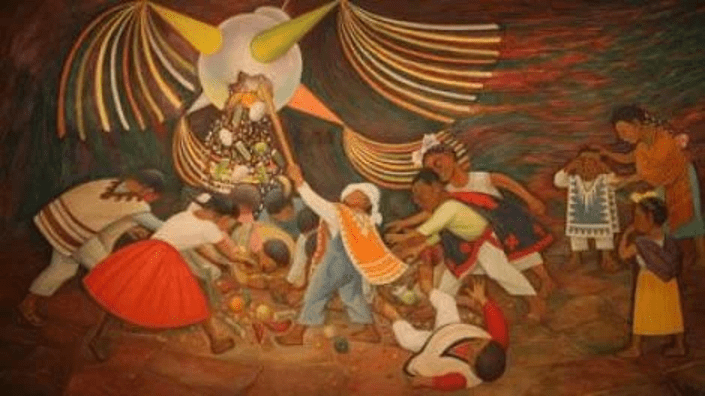
La Piñata, Diego Rivera, 1953
Here in the “New World,” Mayan peoples had for centuries practiced a game in which blindfolded individuals tried to smash a clay pot filled with cacao beans as it was suspended from a string, and Mexicas did something similar during festivities in honor of their war deity, Huitzilopochtli. Spanish Agustinian missionaries, extremely adept at another game called catechizing, jumped at the chance of employing the similarities for their own purposes, and are credited with coming up with the traditional shape of the Mexican piñata in the form of a star with seven peaks, each one representing a capital sin, while the bright colors symbolized temptation. The ancient game thus got transformed into one in which a blindfolded individual to symbolize blind faith uses a stick to strike at Evil after being turned around themselves thirty-three times. Sweets and fruit and other objects that fall from the piñata are the blessings and celestial gifts spread upon those present to reward their fight against Evil and its demons. The ceremony is accompanied by chants that provide a rhythmic trance for the individual to transcend the separation between the earthly and the celestial.
Mientras se rompe la piñata:
Dale, duro, duro, no pierdas el tino
mide la distancia que hay en el camino.
Dale, dale, dale, no pierdas el tino
porque si lo pierdes pierdes el camino.
Dale, dale, dale, dale y no le dio,
quítenle la venda, porque sigo yo!”
Ya le diste una, ya le diste dos
Ya le diste tres y tu tiempo se acabó.
As the piñata is being smashed:
Hit it, hit it hard, do aim well
measure the distance in the path.
Hit it, hit it hard, do aim well
Missing your shot is missing the path.
Hit it, hit it, hit it, no they didn’t
Take off their blindfold, it’s my turn now!
You struck once, you struck twice,
You struck three times and now you’re out
We need to credit Jim for trying to convey our best intentions to CMU lawyers. Here is an excerpt extracted from that virtual paper trail:
“I have had to agree to the university's policy which is that an object (meaning the piñata stick and the pinata contents) won't be handled by multiple people. (…) As far as contents, the university doesn't care if we put money in it, since that is something people won't pass around. They do require if we use university money, that anyone who receives it sign a tax form. I think this is ridiculous not to mention signing a tax form goes against their multiple object handling condition. My thought around this is that I will put $100 of my own money into it which would be 50 wadded up bills (wadded while wearing rubber gloves) in each piñata. Taxes don't apply to non-CMU money and having money come out of it seems like such a great idea. (…) I know this isn't exactly your idea of having hundreds of dollars come out, but I think it will be just as exciting.”
It is uncertain if any matching funds or university money ended up making it into the piñatas, or what procedure would be used to determine whether any ashes found can be traced to the serial number of large denomination bills from CMU coffers. In any case, one last word of caution, as we get ready to engage in one more chapter of this battle against Evil for our communal Covid diaries during the third or fourth of what hopefully will never become a seven-peaked star: no matter how desperate you are to get to pick up some of the lucky charms, being hit on the head with a stick by a blindfolded and unsuspecting individual is not guaranteed to spark a good story, or even worse, to end one.
Our greatest thanks to Jim Duesing, Heather Pertz, and Anna Houck, for helping us coordinate this initiative, as well as to Deans Scheines and Martin and the Advisory Committee for the support and advice. Long life and warm congratulations to the two projects that somehow made it to this side, Gabi Maier, Candace Skibba, and Heather Kelley ‘s “How well?” and Alexa Woloshyn’s “Decolonized Futures.” Likewise to all of the presenters and speakers who generously contributed throughout those almost three years, and for which aside from great knowledge and heartwarming memories, we barely retain lists of names and dates and budgets, and a few photographs like those included below that serve as proof of the magic that could happen when people still got together for dinner and events. Best of luck to coordinators Mary-Lou Arscott & Nico Slate, and Isla Hansen, Annie Hui-Hsin Hsieh, Whitney Laemmli, and Nida Rehman in the Borderlines Initiative as they approach the highly anticipated maturity stages for their projects. Last but not least, thank you to Petra Floyd for designing this lovely brochure, and to Rosabel Kurth for creating the fantastic Covid piñatas.
Felipe Gómez and Rich Pell
Coordinators, Narrative Initiative
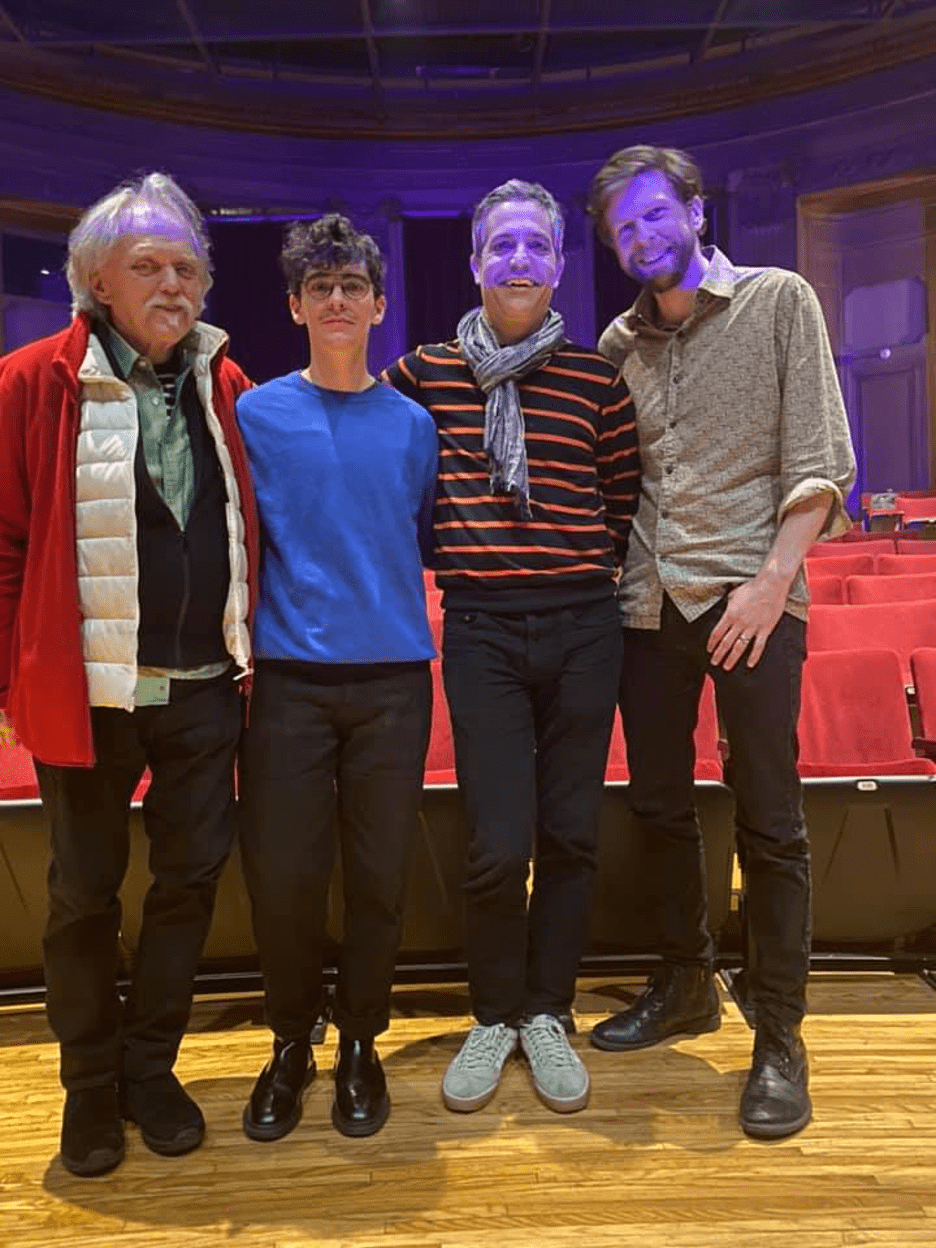
Jim Fouratt, JD Samson, Rich Pell, Sam Green at the performance of “Don’t Call Me Gay Zelig”
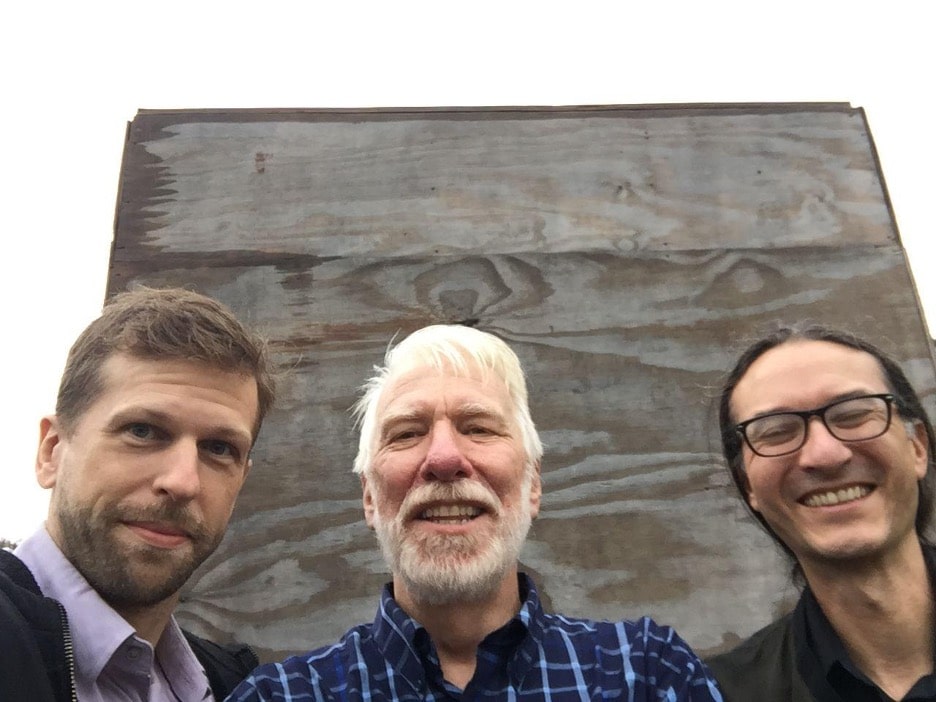
Rich Pell, Jack Hitt and Felipe Gómez go on a field trip to discover the location of the decommissioned Stephen Foster monument while Hitt was in town for his talk ‘Treasure Beneath Falling Statues’.

Jack Hitt in front of a box believed to contain the decommissioned Stephen Foster monument before his ‘Treasure Beneath Falling Statues’ talk.

Box believed to contain the Stephen Foster monument.
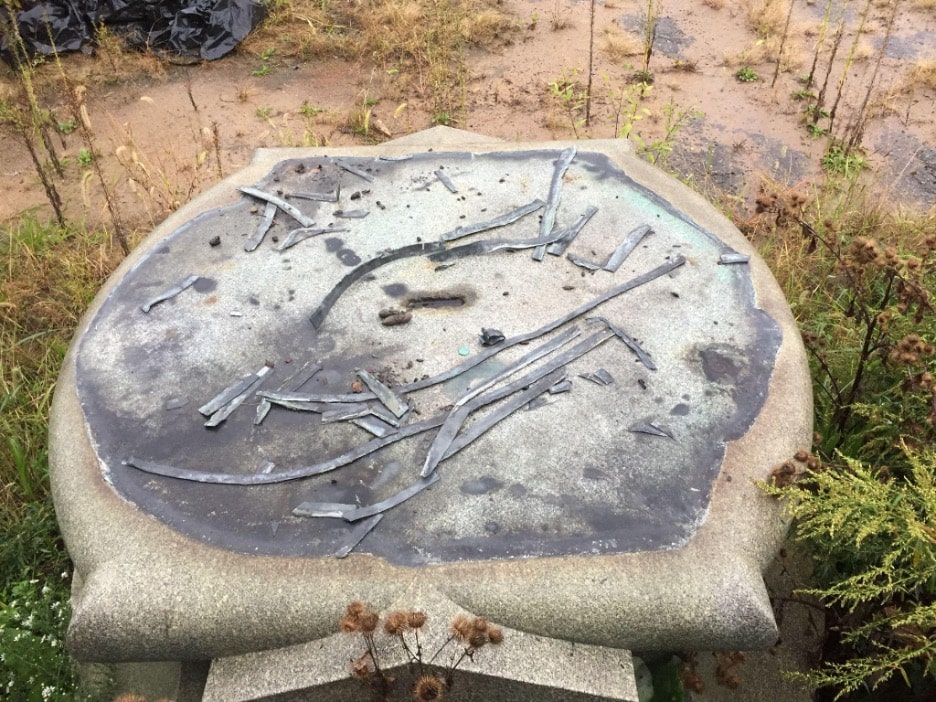
Removed base for the Stephen Foster monument.
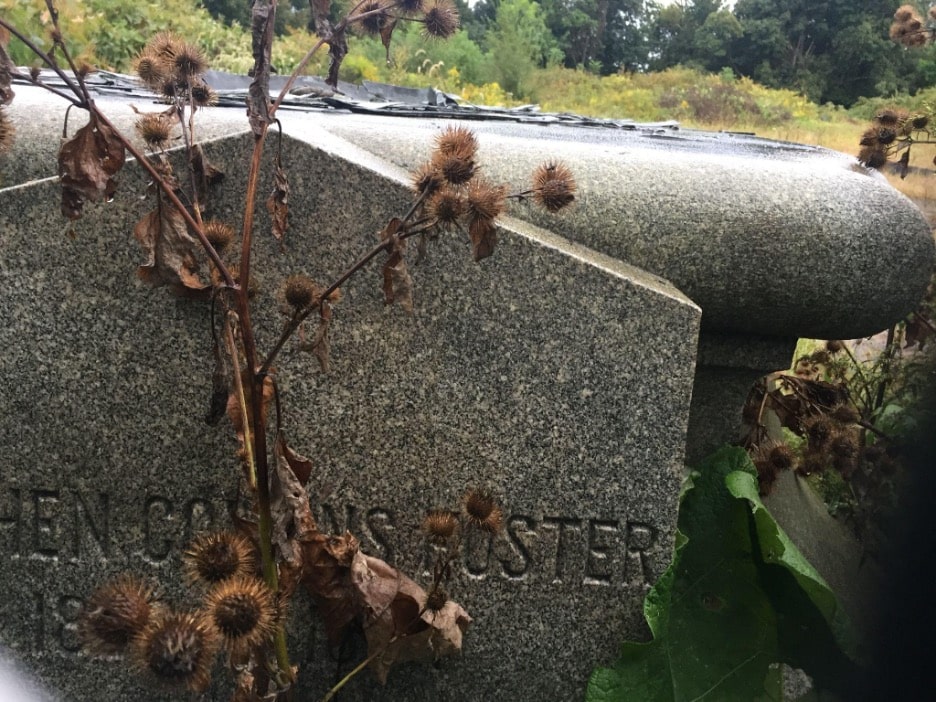
Removed base for the Stephen Foster monument.
